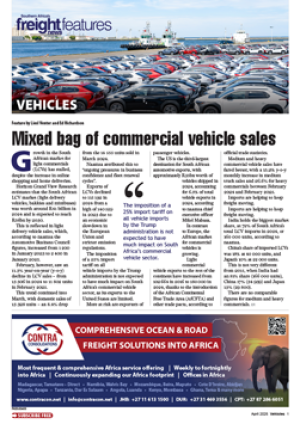Is there a shipping recovery on
the horizon?
That’s a vital question at
the moment, with the global
shipping line sisterhood
having gone through a fiveyear
recession, and still being
financially straitened by an
oversupply of tonnage and weak
freight rates, and a not-toohappy
international trade scene.
The answer, according
to Safmarine southern
Africa cluster manager, Dirk
Hoffmann, is yes and no –
depending on which market you
look at.
“While a weakened currency
has made SA exports more
attractive, it has pushed up
the cost of imported goods –
and import volumes are
down in the face of reduced
consumer demand and
retailers taking longer to
move goods off the shelves
and restock,” he told FTW.
However, he noted, bucking
this trend is Africa, which has
shown strong signs of growth.
In the medium term,
Safmarine expects to see
significant
growth from
the Zimbabwe,
Zambia and
Malawi markets
through
the ports of
Mozambique,
Durban and in
some instances,
Namibia. It
has also seen
increased export
volumes of
tobacco and
cotton.
Automotive
exports and
imports have remained
consistent year-on-year,
according to Hoffmann. “This
said, it’s too early to tell the
longer-term impact the current
industrial action in the auto
sector will have on volume
performance,” he said.
“The European and intra-
Africa reefer markets have
also shown
significant
growth during
the first five
months of 2013.
Refrigerated
cargo exports to
Europe are now
back to 2009
levels thanks,
amongst others,
to a favourable
exchange rate
and an excellent
season.”
According
to the line’s
records, reefer
volumes to Europe in the first
five months of this year were
25% up on the same period last
year.
“It is good to see SA growers
and exporters being rewarded,
this season, after many years
of diligently supplying the
market with returns under
pressure,” Hoffmann said.
“Reefer volumes have increased,
in particular to the UK,
Netherlands and Russia, and
in Africa to Benin, Ghana,
Nigeria, Senegal and Togo.”
He also pointed out that
the Middle East region also
continued to show steady
growth for perishable cargo,
and that fruit was now moving
directly into the mainland
Chinese ports.
“We’ve seen a dramatic shift
in volumes away from Hong
Kong for grapes and
citrus directly into
the other Chinese
ports such as
Nansha, Yantian
and Shanghai,”
Hoffmann said.
Matt Conroy,
Maersk Line’s trade and
marketing manager, believes
demand is still not overly strong
to support a recovery.
“Maersk Line improved
results are a reflection
of improved operational
efficiencies (resulting
in lower fuel
spend),
rather than
an increase
in freight
rates and
volume,”
he told
FTW.
INSERT & CAPTION
In the medium term,
Safmarine expects to
see significant growth
from the Zimbabwe,
Zambia and Malawi
markets.
– Dirk Hoffmann

